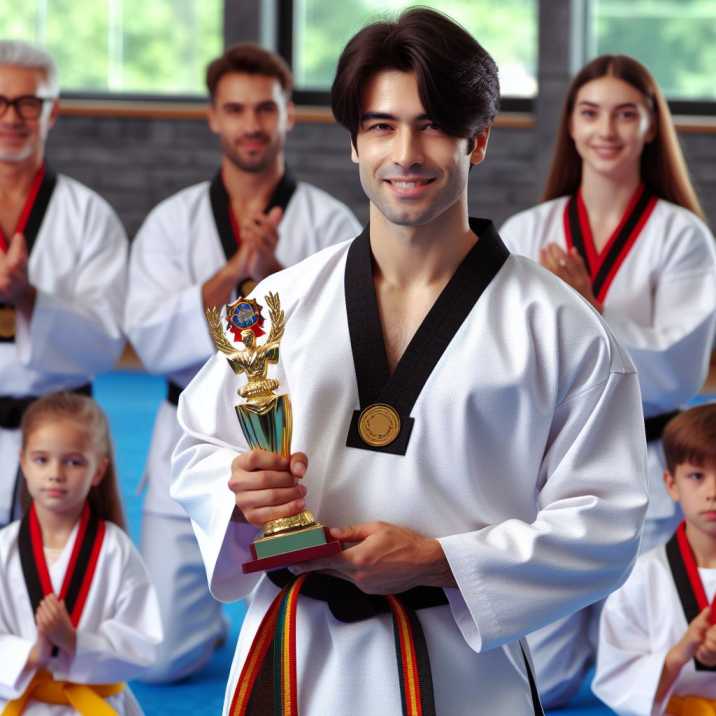Introduction
Table of Contents
How Many Taekwondo Grandmasters?
Taekwondo, with its dynamic kicks and powerful strikes, has gained global recognition as a martial art and an Olympic sport. At the pinnacle of this discipline are the revered grandmasters, individuals who have achieved the highest level of expertise and mastery. In this exploration, we aim to answer a burning question: how many Taekwondo Grandmasters?
Unraveling the Legacy of Taekwondo Grandmasters
Taekwondo, translated as “the way of the hand and foot,” originated in Korea and has a rich history dating back to the mid-20th century. The journey to becoming a grandmaster in Taekwondo is not only arduous but also deeply symbolic. It involves mastering techniques, understanding the philosophy, and demonstrating leadership in the Taekwondo community.

The Quest for Grandmaster Status
To comprehend the number of Taekwondo grandmasters, it’s essential to understand the grading system. Taekwondo practitioners progress through various color belts before reaching the coveted black belt. The grandmaster status is typically associated with those holding the 9th or 10th Dan, the highest black belt ranks.
How Many Taekwondo Grandmasters Exist Today?
How many Taekwondo Grandmasters? Pinpointing the exact number of Taekwondo grandmasters globally is a challenge due to the decentralized nature of Taekwondo organizations. Different associations and federations have their own criteria for awarding grandmaster status. However, estimates suggest that there are approximately 300 to 500 9th and 10th Dan black belts worldwide.
Insights from Taekwondo Organizations
The World Taekwondo Federation (WTF) and the International Taekwon-Do Federation (ITF) are two major governing bodies in the world of Taekwondo. Both organizations recognize and honor grandmasters, but their approaches to the ranking system and criteria for promotion may vary.
The Influence of Cultural Factors
Cultural nuances also play a significant role in determining how many Taekwondo Grandmasters? In Korea, the birthplace of Taekwondo, there is a profound respect for the martial art, leading to a higher concentration of grandmasters. In contrast, other regions may have fewer grandmasters due to varying levels of cultural integration.
The Rising Popularity and Grandmaster Titles
With the global surge in interest in martial arts, particularly Taekwondo, the number of grandmasters is on the rise. More individuals are dedicating their lives to mastering the art and reaching the esteemed status of grandmaster.
An Information-Based Table: Quick Reference
| Continent | Estimated Grandmasters | Prominent Organizations |
|---|---|---|
| Asia | 200-300 | WTF, ITF, Local Bodies |
| North America | 50-100 | USA Taekwondo, ITF-NA |
| Europe | 30-50 | European Taekwondo Union |
| Africa | 10-20 | African Taekwondo Union |
| Oceania | 10-20 | Oceania Taekwondo Union |
This table provides a snapshot of the distribution of Taekwondo grandmasters across different continents and highlights the influence of major Taekwondo organizations.
The Varied Paths to Grandmaster Status
Becoming a Taekwondo grandmaster is not just about skill; it involves a commitment to the values of integrity, perseverance, and indomitable spirit. Grandmasters often dedicate their lives to teaching and spreading the art of Taekwondo.
The Role of Teaching and Leadership
Many grandmasters actively contribute to the community by running their own dojangs (training schools) and mentoring the next generation of martial artists. Their impact extends beyond the physical aspects of Taekwondo, influencing the character development of their students.
The Global Taekwondo Community
The worldwide Taekwondo community is a tapestry of diverse cultures, languages, and traditions. Grandmasters serve as cultural ambassadors, fostering unity and understanding through the shared language of Taekwondo.
Conclusion: The Enigma of Taekwondo Grandmasters
In conclusion, How Many Taekwondo Grandmasters? the exact number of Taekwondo grandmasters remains elusive due to the decentralized nature of Taekwondo organizations and varying criteria for promotion. However, it is evident that the influence of grandmasters extends far beyond the realm of martial arts. They are custodians of a legacy, shaping the present and future of Taekwondo.

FAQs: Your Burning Questions Answered
- Q: How does one become a Taekwondo grandmaster?
- A: Achieving grandmaster status involves reaching the 9th or 10th Dan black belt, demonstrating mastery, and contributing significantly to the Taekwondo community.
- Q: Are there female Taekwondo grandmasters?
- A: Yes, there are female Taekwondo grandmasters, breaking traditional gender barriers in martial arts.
- Q: Can a grandmaster belong to multiple Taekwondo organizations?
- A: Yes, some grandmasters may be affiliated with multiple organizations, contributing to the global diversity of Taekwondo.
- Q: Are there age restrictions for becoming a grandmaster?
- A: While there are no strict age restrictions, achieving grandmaster status often requires years of dedication and experience.
- Q: How does the grandmaster title vary between different Taekwondo organizations?
- A: Different organizations may have distinct criteria and requirements for awarding the grandmaster title.
- Q: Are there famous Taekwondo grandmasters?
- A: Yes, there are renowned Taekwondo grandmasters who have made significant contributions to the development of the martial art.
- Q: What is the significance of the 9th and 10th Dan black belts?
- A: The 9th and 10th Dan black belts are the highest ranks in Taekwondo, symbolizing the pinnacle of expertise and mastery.
- Q: How often does a Taekwondo grandmaster undergo testing for promotions?
- A: The frequency of testing for promotions varies among organizations and may depend on the individual’s contributions and achievements.
- Q: Can grandmasters still compete in Taekwondo tournaments?
- A: While some grandmasters may choose to compete, their primary focus is often on teaching, leadership, and mentorship.
- Q: Are there Taekwondo grandmasters in non-traditional Taekwondo practicing countries?
- A: Yes, the global appeal of Taekwondo has led to the presence of grandmasters in countries with non-traditional


